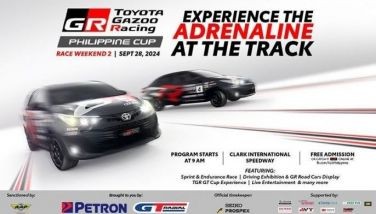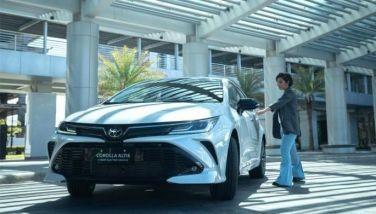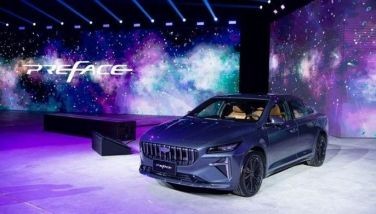Driving the Subaru Outback 3.6R
MANILA, Philippines - At first glance, it’s easy to be confused between two of Subaru’s wagon-bodied models, the Legacy and the Outback. For one thing, they look almost the same; in fact, the Outback is based on the Legacy wagon.
But while the Legacy comes in sedan and wagon body styles, the Outback comes exclusively as a wagon. So what’s the diff between the two, you ask?
Simple. One is designed to perform its overachieving driving capabilities on the road, while the other has been blessed with a few changes to perform a similar magic even when the road ends and rougher terrain begins.
And it’s easy to see which is which. The Legacy 2.5GT sits hunkered down on the road on its 18-inch wheels and ultra-low-profile 225/45R-18 tires. The Outback 3.6R, on the other hand, sits two inches higher off the ground and rolls on higher-profile 225/60R-17 all-terrain tires.
Outwardly, the Outback 3.6R underwent enough aesthetic changes to make it look different from the Legacy 2.5GT if not in silhouette, at least in detail. Gone is the hood scoop that feeds the Legacy’s intercooler. The Outback’s front grille has vertical slats instead of the Legacy’s chrome bar-and-mesh treatment. The front and rear bumpers are completely different, with the Legacy’s front bumper sporting very aggressive intake openings.
From the side, the Outback loses the Legacy’s side skirts, a body appendage that is first to get damaged once a vehicle ventures off-road.
Needless to say, the numeric model designations also hint at the major difference under the hood. While the Legacy GT packs a 2.5-liter 4-cylinder turbo-intercooled motor, the Outback comes with 3.6-liter 6-cylinder non-turbo powerplant.
And while the two horizontally opposed engines have varying numbers in terms of displacement and piston count, their power outputs are surprisingly similar: 265 ps and 350 Nm for the Legacy and 260 ps and an identical 350 Nm for the Outback.
The big difference is in the spread of torque. The Legacy’s turbo engine enables it to enjoy that prodigious torque output from as low as 2,700 rpm all the way to 5,200 rpm, the Outback’s normally aspirated engine generates its 350 Nm at 4,400 rpm.
Result? The Legacy simply feels much faster. Plunge your right foot down and the Legacy scoots forward almost instantly. In contrast, the Outback has a more gradual acceleration – almost like a jetliner taking off. It’s not scintillatingly fast (like the Legacy), but you know you’re making serious speed. Which is probably better if you plan to do any type of off-roading. Smoothness, especially in power application, is key to survival in the boondocks; not rocket-sled acceleration.
And while the Legacy’s turbo motor is commendably smooth, the Outback’s flat-6 is smoother and quieter still – with just the right amount of purr and throb to remind you that a high-performance boxer engine is under the hood.
Just don’t expect Impreza-like grip when the pavement gets twisty. The raised ride height results in a higher center of gravity; and coupled with the higher-profile all-terrain tires, can leave the Outback squealing for grip when the Legacy is pulling away with nary a chirp from its high-performance street tires.
Performance-wise, this translates to the Legacy outrunning the Outback (at least on pavement) with a stellar 0-100-kph acceleration time of 6.3 seconds while the 30-kg heavier Outback needs a still-impressive 7.3 seconds to accomplish the same feat.
Top speed is a similar story, with the Legacy attaining a sports car-like 245 kph while the less aerodynamically efficient Outback is limited to a still-fast 230 kph.
Both cars have Subaru’s state-of-the-art Symmetrical All-Wheel-Drive with SI-Drive and Variable Torque Distribution or VTD. They also share identical gear ratios for their 5-speed paddle-shift automatics as well as identical final drive ratios.
The Subaru Intelligent-Drive (SI-DRIVE) is standard in the Outback 3.6R and the Legacy 2.5GT. It has three different modes (Intelligent, Sport, and Sport Sharp) to suit three distinct driving styles and situations. “Intelligent” is the best compromise for everyday driving as it delivered the most relaxed and comfortable performance. I rarely used “Sport” because whenever I felt the urge to give this Subie the spurs, I went straight to “Sport Sharp.” And boy, does it make this wagon really haul! It does so by tweaking the drive-by-wire system to deliver higher shift points for maximum engine power, even blipping the throttle to match revs for smooth downshifts and instantaneous power.
Inside the Outback’s leather-lined cockpit, you’ll find a superb balance between luxury and functionality. The doors open almost 90 degrees wide. Fit and finish are commensurate to a car costing 2.398 million bucks. The seats are very supportive and feel like they would be at home in a BMW. The rear seats’ backrest can be reclined to give rear occupants a more relaxed sitting position. Even the inner door panels have handsome sculpting and are luxuriously finished.
Last but not least, I applaud the Outback’s key-in-your pocket smart lock/unlock with push-button engine start/stop. Other comfort and convenience features include automatic rain-sensing wipers, auto-on/off headlamps, electronic push-button parking brake, 10-way power-adjustable driver’s seat, 8-way power-adjustable passenger’s seat, dual-zone climate control with aircon vents for the rear seat passengers, and a multi-info trip computer.
The Outback’s ring-shaped reinforcement frame body it shares with the Legacy has evolved to provide higher-impact absorbing capacity from any direction. All-round safety is further ensured with the advanced Vehicle Dynamics Control (VDC) system and the dual front, side, curtain, and knee airbags.
Subaru seems to have gone over every little detail in the pursuit of low NVH and high refinement. One telling evidence is how the doors sound when you close them. Close a door gently and the sound is one of hushed solidity. Slam it as hard as you can, though, and the sound remains exactly the same: hushed solidity. Impressive.
No surprise then that the Outback was voted as Motor Trend’s Sport/Utility of the Year, besting premium (and much more expensive) SUVs like the Mercedes-Benz GLK, Volvo XC60, Acura CDX, Audi Q5, Cadillac SRX, and Lexus 350. It really is that good.
THE GOOD
Smooth, strong engine
5-speed paddle-shift manumatic
High levels of refinement/low NVH
Spacious, luxurious cabin
Lots of safety features
Impressive build quality
Superb sound system
THE BAD
Still looks more like a station wagon than a macho off-roader (hello, Forester)
Can display a fondness for premium fuel, if you’ve got a heavy right foot
THE VERDICT
A high-performing wagon/SUV crossover with more wagon (and less SUV) DNA.
- Latest






























